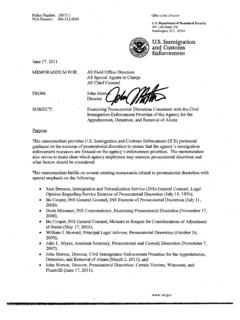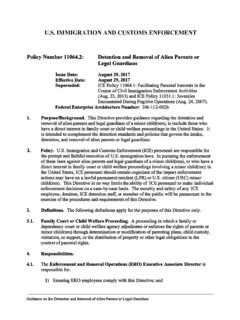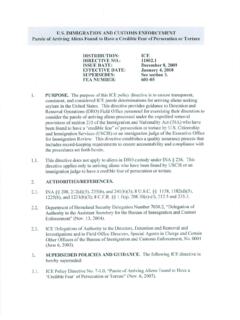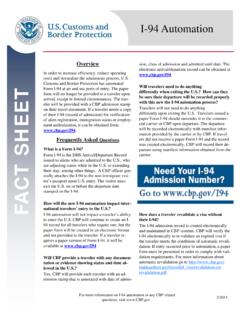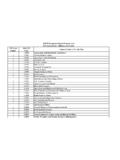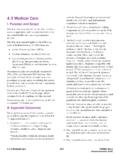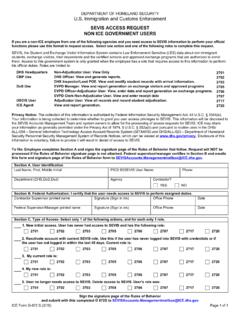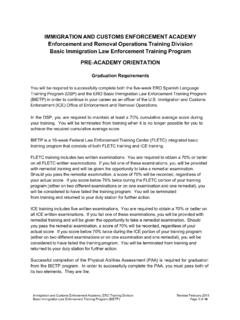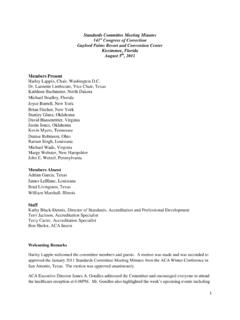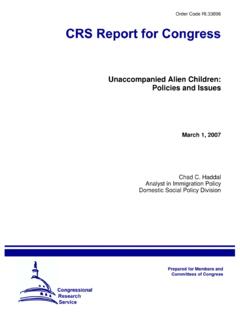Transcription of ICE/DRO DETENTION STANDARD
1 ICE/DRO DETENTION STANDARD FOOD SERVICE I. PURPOSE AND SCOPE. This DETENTION STANDARD ensures that detainees are provided a nutritionally balanced diet that is prepared and presented in a sanitary and hygienic food service operation. It applies to the following types of facilities housing DRO detainees: Service Processing Centers (SPCs); Contract DETENTION Facilities (CDFs); and State or local government facilities used by DRO through Intergovernmental Service Agreements (IGSAs) to hold detainees for more than 72 hours. Procedures in italics are specifically required for SPCs and CDFs. IGSAs must conform to these procedures or adopt, adapt or establish alternatives, provided they meet or exceed the intent represented by these procedures. Some terms used in this document may be defined in the separate Definitions STANDARD . II. EXPECTED OUTCOMES. The expected outcomes of this DETENTION STANDARD are: 1.
2 All detainees will be provided nutritionally balanced diets that are reviewed at least quarterly by food service personnel and at least annually by a qualified nutritionist or dietitian. 2. Detainees, staff and others will be protected from harm and facility order will be maintained by the application of sound security practices in all aspects of food service and dining room operations. 3. Detainees, staff, and others will be protected from injury and illness by adequate food service training and the application of sound safety and sanitation practices in all aspects of food service and dining room operations. 4. Dining room facilities and operating procedures will provide sufficient space and time for detainees to eat meals in a relatively relaxed, unregimented atmosphere. 5. Food service facilities and equipment will meet established governmental health and safety codes, as documented by an independent, outside source.
3 6. Detainees, staff, and others will be protected from health-related harm by advance medical screening and clearance before any detainee is assigned to work in food service operations. 7. Food service areas will be continuously inspected by food service staff and other assigned personnel on schedules determined by the food service administrator and by applicable policy requirements. Food Service 1 December 2, 2008 8. Stored food goods will be maintained in accordance with required conditions and temperatures. 9. Therapeutic medical diets and supplemental food will be provided as prescribed by appropriate clinicians. diets and special ceremonial meals will be provided for detainees whose religious beliefs require the adherence to religious dietary laws. will receive a religious or special diet free of any personal cost. will never be used for reward or punishment. III. DIRECTIVES AFFECTED. This DETENTION STANDARD replaces Food Service dated 9/20/2000.
4 IV. REFERENCES American Correctional Association standards for Adult Local DETENTION Facilities, 4th Edition: 4-ADLF-4A-01 through 4A-18. (Five of those Expected Practices are mandatory for accreditation: 4A-07, 4A-11, 4A-13, 4A-15, and 4A-16.) ICE/DRO DETENTION STANDARD on Tool Control ICE/DRO DETENTION STANDARD on Key and Lock Control FDA Public Health Services Food Code V. EXPECTED PRACTICES A. Administration 1. Food Service Administrator or Equivalent. The food service program shall be under the direct supervision of an experienced food service administrator (FSA) who is responsible for: Planning, controlling, directing, and evaluating food service; Training and developing the cook foremen; Managing budget resources; Establishing standards of sanitation, safety and security; Developing nutritionally adequate menus and evaluating detainee acceptance of them; Developing specifications for the procurement of food, equipment, and supplies; and Establishing a training program that ensures operational efficiency and a high quality food service program.
5 Ordinarily, a food service department is also staffed by one or more cook supervisors (CS) and cook foremen (CF), although the organizational structure differs among facilities, particularly when food service is provided by a food service contractor. References to the CS and CF in this DETENTION STANDARD describe typical Food Service 2 December 2, 2008 duties for those positions, although the functions may be performed by others, depending on the organizational structure. B. Security 1. Custody and Security The facility s custody and security policy and procedures shall address the buildings or portions of buildings housing the food service department; all the types of detainee traffic in and out of the department; detainee behavior; control of repairs; control of utensils with a custodial hazard potential (knives, cleavers, saws, tableware, etc.); official counts and census; shakedowns; and any other matters having a direct or indirect bearing on custody and security.
6 The facility s training officer shall devise and provide appropriate training to all food service personnel in detainee custodial issues. Among other things, this training shall cover ICE/DRO s DETENTION standards . 2. Knife Control The knife cabinet must be equipped with an approved locking device. The on-duty cook foreman, under direct supervision of the CS, shall maintain control of the key that locks the device. Knives must be physically secured to workstations for use outside a secure cutting room. Any detainee using a knife outside a secure area must receive direct staff supervision. Knives should be inventoried and stored in accordance with the DETENTION STANDARD on Tool Control. To be authorized for use in the food service department, a knife must have a steel shank through which a metal cable can be mounted. The facility's tool control officer is responsible for mounting the cable to the knife through the steel shank.
7 The FSA/CS shall monitor the condition of knives and other food service utensils, disposing of items not in good working order and ordering replacements. If a knife is misplaced or lost, staff shall immediately notify the FSA and chief of security, and shall hold detainees who may have had access to the missing knife in the area until a thorough search is conducted. The responsible CS shall provide the details of the loss in a written report to the chief of security. The knife cabinet shall meet the tool-control standards of the Occupational Safety and Health Administration, as well as any site-specific standards developed by the facility. 3. Key Control Keys should be inventoried and stored in accordance with the DETENTION STANDARD on Key and Lock Control. The control room officer shall issue keys only in exchange for a name chit from receiving staff. Under no circumstances shall detainees have access to facility keys.
8 The cook supervisor shall return the keys to the control room before going off duty. At no time may anyone carry facility keys outside the facility. Food Service 3 December 2, 2008 4. Controlled Food Items/Hot Items All facilities shall have procedures for handling food items that pose a security threat. a. Yeast and Yeast Products All yeast must be stored in an area with no detainee access, preferably in a locked metal yeast cabinet for which the food service department has only one key. The locked yeast cabinet should be kept in a locked area. Until the yeast is thoroughly incorporated as an ingredient in the item being prepared, only one member of the food service staff, closely supervised, may handle and dispense it. Staff shall keep a record of the yeast inventory (in pounds and ounces), indicating quantity of receipt and issue, balance on hand, and the record keeper s initials.
9 B. Other Food Items Mace, nutmeg, cloves, sugar, and alcohol-based flavorings also require special handling and storage. The purchase order for any of these items shall specify the special-handling requirements for delivery. Staff shall store and inventory these items in a secure area in the food service department. Staff shall directly supervise use of these items. 5. Shakedowns All facilities must establish daily searches (shakedowns) of detainee work areas (trash, etc.) as STANDARD operating procedures, paying particular attention to trash receptacles. Searches of detainees leaving certain work areas (for example, bakery, vegetable preparation, dining room, warehouse) are required to reduce the possibility that hot food or contraband can leave the restricted area. Unless directed otherwise by facility policy or special instructions, staff shall prevent detainees from leaving the food service department with any food item.
10 Food service personnel as well as facility DETENTION staff shall conduct shakedowns. 6. Counts The FSA shall establish procedures for informing staff of the local counting procedures and for ensuring that the procedures are followed. Staff must be able to account for detainees at all times. The counting officer must have a staff observer/backup during each count. Detainees should be assembled in one section of the dining room and be required to remain seated until their names are called and then move to another section of the dining room. Food Service 4 December 2, 2008 C. Detainee Workers 1. Detainee Workforce Detainees may volunteer for work in accordance with the DETENTION STANDARD on the Voluntary Work Program and must work in accordance with the DETENTION STANDARD on Classification System. The number of detainees assigned to the food service department shall be based on a quota developed by the FSA and approved by the facility administrator.
